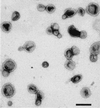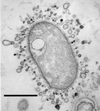Structures of gram-negative cell walls and their derived membrane vesicles
- PMID: 10438737
- PMCID: PMC93954
- DOI: 10.1128/JB.181.16.4725-4733.1999
Structures of gram-negative cell walls and their derived membrane vesicles
Figures









References
-
- Amako K, Murata K, Umeda A. Structure of the envelope of Escherichia coli observed by the rapid freezing and substitution fixation method. Microbiol Immunol. 1983;27:95–99. - PubMed
-
- Bayer M E. Zones of membrane adhesion in the cryofixed envelope of Escherichia coli. J Struct Biol. 1991;197:268–280. - PubMed
-
- Beveridge T J. Ultrastructure, chemistry, and function of the bacterial cell wall. Int Rev Cytol. 1981;72:229–317. - PubMed
Publication types
MeSH terms
Substances
LinkOut - more resources
Full Text Sources
Other Literature Sources

